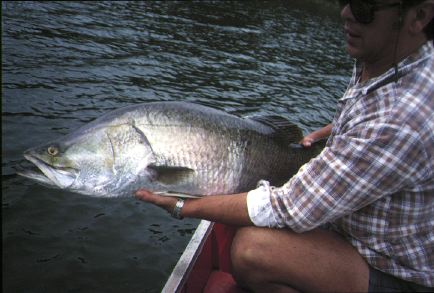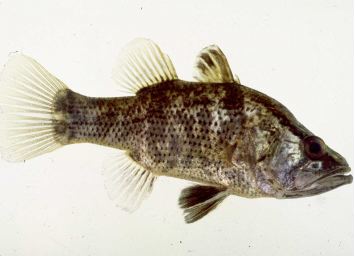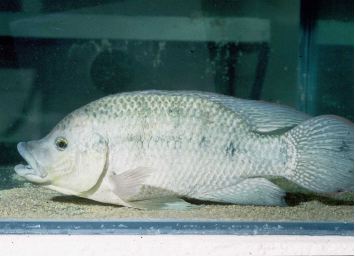You may have the opportunity to go fishing when you go on camp. We have a special permit which allows us to use a dragnet. This allows us to catch, study and release fish in the dam. Fishing is a wonderful recreation enjoyed by many people. We really need to think about helping to care for our fish stocks. We need to fish sustainably.
Native fish
The photos of these fish are kindly reproduced courtesy of DPI Fisheries QLD
Barramundi
Barramundi are a native fish that can be found in all river systems of North Queensland. These fish are found along most of the length of a river although the fish must return to salt water to mature, spawn and produce young. The larvae need to live in the coastal wetlands as they grow. Filling in swampy areas and removing mangroves will harm the barramundi's existence. Adults range in colour from silver to golden brown. Juveniles may have a white stripe running along their head. Barramundi can grow to 1.8m and 60 kg.

They are carnivorous, eating smaller fish and crustaceans. Breeding usually occurs in the warmer summer months. Because the fish breed at this time, there is a closed season from the 1st November to 1st February each year, when fishermen are not allowed to keep any Barramundi they catch. Barramundi begin life as neither male nor female. When they reach about 20cm they change to males. They then change into females when they reach about 70 cm in length, this takes between 3 and 5 years. The Barramundi is a favoured fish for anglers because of the spectacular way they 'jump' from the water and 'dance' when they are hooked. They are also delicious to eat. These qualities make them a fish that is targeted by most fishermen. To ensure the survival of the barramundi, the government has introduced strict regulations about the catching of these fish.
Barramundi Regulations
- Closed season 1 November to 1 February
- Minimum size - 58cm
- Maximum size - 120cm
- Bag Limit - 5
Tinaroo Dam
Barramundi do not occur naturally in the Barron River (above the Barron Falls) and Tinaroo Dam on the Tablelands. However, the dam has been stocked with the fish for Recreation. This only took place after extensive research to ensure that there would be no adverse effects on the environment or its inhabitants.
These fish do not breed because they are not able to reach saltwater, however they still possess a natural instinct to do so.
In the past when water flooded over the spillway many of the fish swam over the wall and were killed. The Department of Primary Industries and the local Fish Stocking Society now put a barrier net across the dam to stop the fish killing themselves.
Recently a World Record sized Barramundi (38kg) for 6kg fishing line was caught in Tinaroo.
Rainbows
These small, colourful fish inhabit most of the waterways in northern Australia. There are at least 20 different species of Rainbows found in Australia. These small fish make excellent aquarium fish. It is far better to have Australian native species in your aquarium than imported species such as guppies or swordtails.

A Rainbow found in the local area is most likely to be the Eastern Rainbow. They feed on pretty much whatever they can find; plants, aquatic insects and insect larvae, crustaceans and plankton. The Rainbow is also an excellent controller of mosquito larvae. Other fish introduced for this purpose are not as effective at controlling mosquito numbers and yet endanger the existence of this and other native fish. Another species of Rainbow called the Lake Eacham Rainbow has become extinct in Lake Eacham because of the introduction of other species into the lake.
Mouth Almighty
Mouth Almighty are common in almost all north-east Queensland rivers and streams. They are present in Tinaroo Dam.

The Mouth Almighty are usually greenish-brown and have a mottled appearance. They find cover in amongst weeds and snags - their colour blending in beautifully with their surroundings. This is obviously their main defence mechanism.
They are carnivores and sit in ambush waiting for other small fish, insects and crustaceans.
They have an enormous mouth and grow up to 20 cm long. The bigger fish are good eating especially cooked whole wrapped in alfoil and cooked on the coals.
These fish breed all year round. As with most native fish they lay eggs but unlike other fish, whose eggs usually rest on vegetation in the water, the male broods the eggs in his mouth for about two to three weeks. He keeps the live young in his mouth for a short while before releasing them to fend for themselves. Fish that do this are called 'mouth brooders'.
The Mouth Almighty was introduced into Lake Eacham and were one of the main culprits in the elimination of the Lake Eacham Rainbow Fish. This illustrates how fragile the balance is in nature sometimes; two species of native fish but one eliminates the other because it does not belong.
Introduced fish
When fish from aquariums are released into our waterways they nearly always have devastating effects. These exotic fish are not meant to live in our local conditions. Some will die, but others will breed out of control and destroy our native fish populations.
Guppies: (aquarium fish released into the wild)
The guppy is an aquarium fish (from South America) that people have released into our Australian Waterways. It eats the eggs of our native fish and nips the fins of other larger fish.
Tilapia: (Exotic fish set to take over)
The Tilapia is a native of Africa. It should not be in our waterways. It eats the food that should be there for our native species. They are omnivores, eating mainly plants but also insects, crustaceans and aquatic invertebrates.
It can survive in salt water and in polluted water. There is a very real danger that the Tilapia will swim up stream from the ocean and infest the creeks and rivers of North Queensland and wipe out the native fish.

The Tilapia breeds very quickly. They are mouthbreeders and protect their eggs and young in their mouth. 5 Tilapia were released into a resort lagoon at Port Douglas in 1989. Within 3 years, the population had grown to over 1 million fish.

These fish have greenish to almost black bodies and can grow up to 30-40 cm long and can weigh up to 2 kg.
If caught they must be destroyed. The future of our native fish species depends on it. Heavy fines have been imposed, by the government, for anyone who releases a tilapia into any waterway.